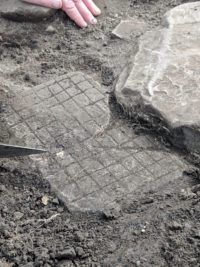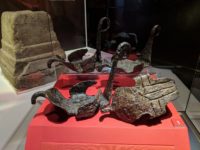 A stone gameboard has been unearthed at the Roman fort of Vindolanda just south of Hadrian’s Wall in Northumberland. A volunteer discovered the 3rd century board in the floor of a building behind the bath house. It seems the stone slab with an incised grid was recycled for use a flooring in the structure.
A stone gameboard has been unearthed at the Roman fort of Vindolanda just south of Hadrian’s Wall in Northumberland. A volunteer discovered the 3rd century board in the floor of a building behind the bath house. It seems the stone slab with an incised grid was recycled for use a flooring in the structure.
It is thought that the board would have been in use in the bath house and then utilised elsewhere after it was broken.
“You can almost picture the losing Roman tipping the board up in frustration, causing it to break,” said a Vindolanda spokesperson.
A total of five good examples of gaming boards have been found at Vindolanda over the years, and all date from the third and fourth centuries.
The board was probably used to play ludus latrunculorum, a checkers-like game in which two players move pieces across the board. When a player’s piece is trapped between two of his opponents’ pieces, it is captured and removed from the board. The player who captures all of his opponent’s pieces wins the game. Stone and glass game pieces have also been found in past excavations at Vindolanda.
 In other Vindolanda news (there is never not news from Vindolanda), the complete set of four hipposandals found last year have been conserved and put on display at the Roman Army Museum. The Vindolanda Charitable Trust’s blog has a brief and fascinating explanation of how the iron sandals may have been used. They weren’t worn by horses the way horseshoes are worn today, that much is certain. Check it out.
In other Vindolanda news (there is never not news from Vindolanda), the complete set of four hipposandals found last year have been conserved and put on display at the Roman Army Museum. The Vindolanda Charitable Trust’s blog has a brief and fascinating explanation of how the iron sandals may have been used. They weren’t worn by horses the way horseshoes are worn today, that much is certain. Check it out.
Also, a collection of ox crania found at Vindolanda that show evidence of having been used as target practice have been 3D imaged and uploaded to Sketchfab. Examination of the trauma and comparisons with arrowheads found at Vindolanda confirmed that the holes were indeed caused by repeated arrow shots, so many that the right anterior of the bovine skull was separated from the cranium by the sheer number of projectiles. There were some holes from a lancehead too, likely caused by a spear being used to stake up the cranium for use in target practice.